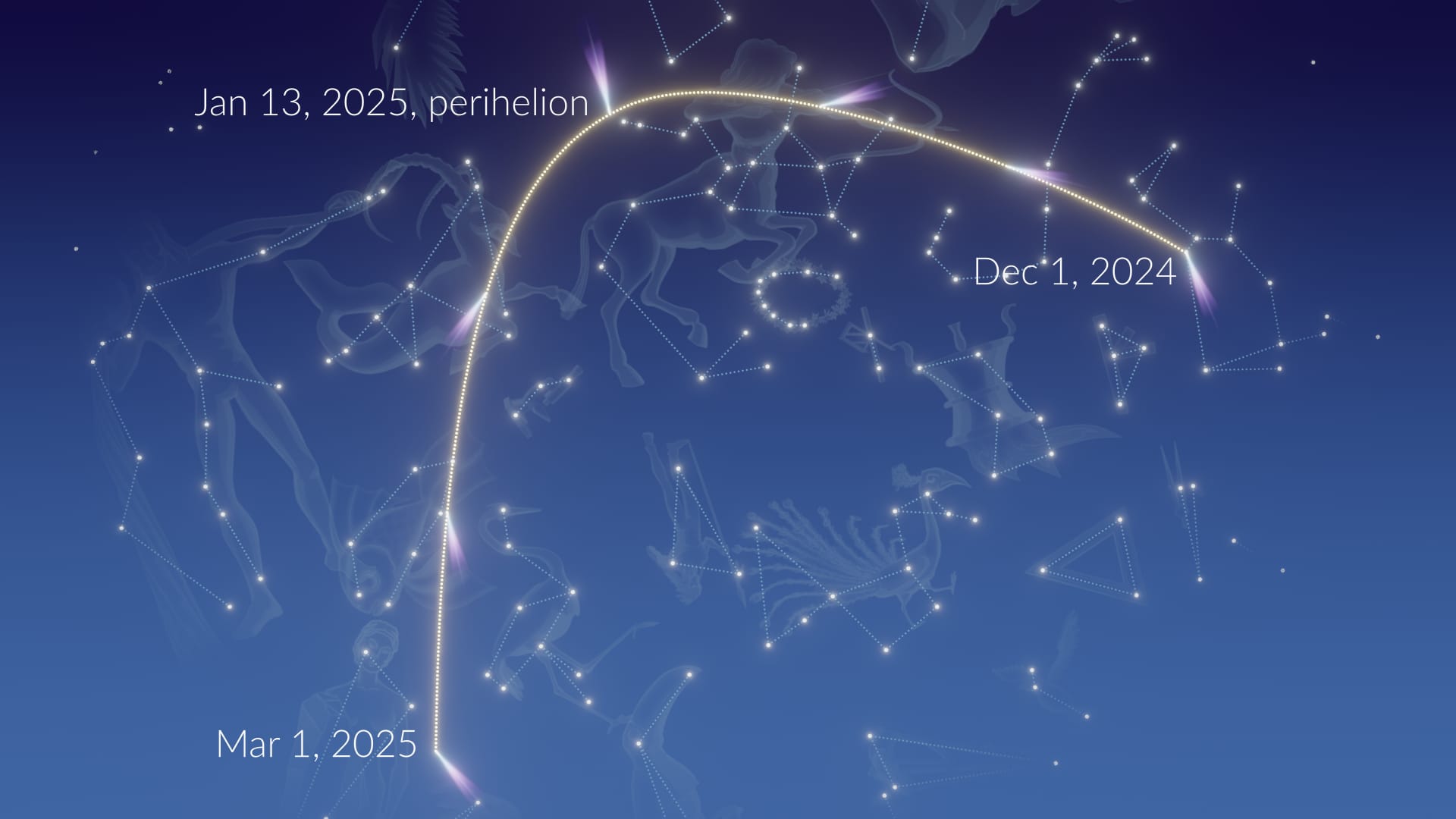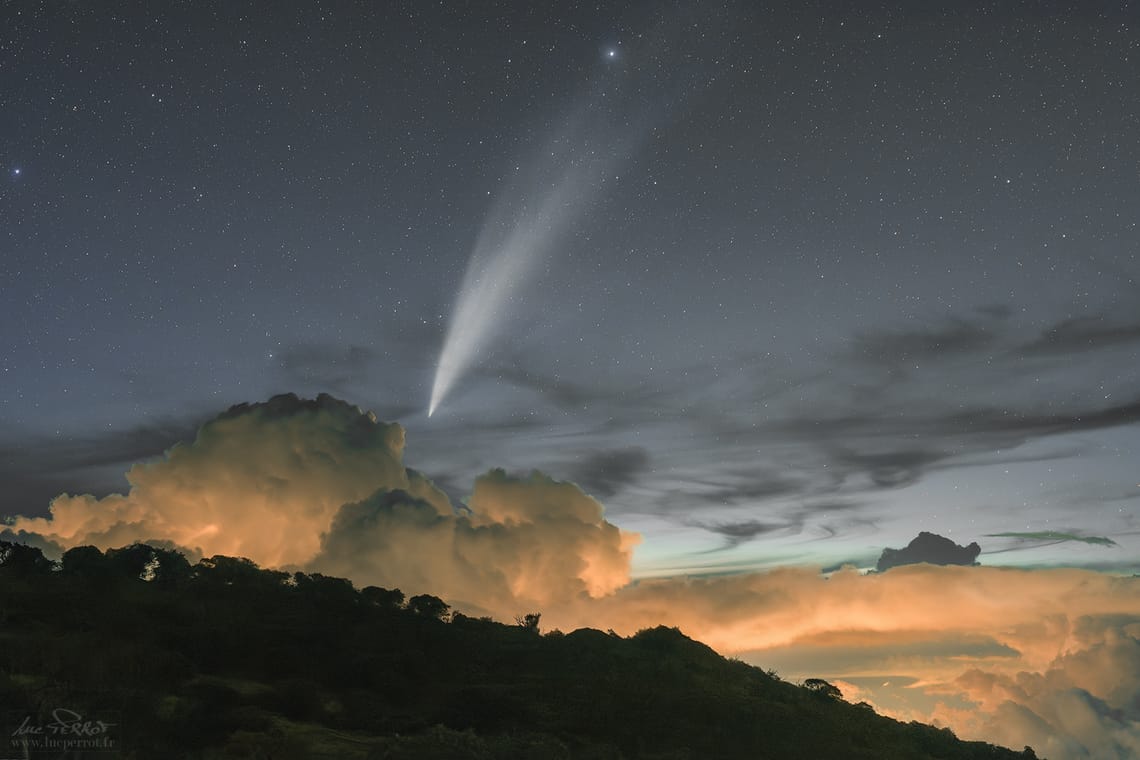Comet G3 ATLAS — a Ghost Comet That Refuses to Disappear
Comet C/2024 G3 (ATLAS) brought plenty of excitement for amateur astronomers and astrophotographers at the beginning of 2025. Despite losing its “head” to the Sun’s intense heat, it remained an amazing sight. In fact, its large, beautiful tail continued to fluff out above the horizon in the Southern Hemisphere. Use the free Sky Tonight app to locate C/2024 G3 or any other comet in the sky and read on for more details about the best comet of 2025!
Contents
- Comet C/2024 G3 (ATLAS): General info
- When and how to observe C/2024 G3 (ATLAS)
- Discovery of C/2024 G3 (ATLAS)
- Comet C/2024 G3 (ATLAS): Bottom line
Comet C/2024 G3 (ATLAS): General info
- Type: non-periodic comet
- Orbital period: unknown
- Perihelion: January 13, 2025
- Closest approach to Earth: January 13, 2025
- Maximum brightness: -3.4
- Best visible from: Southern Hemisphere
When and how to observe C/2024 G3 (ATLAS)
Comet C/2024 G3 reached its closest point to the Sun on January 13, 2025. At that moment, it was four times closer to the Sun than Mercury (0.094 AU) and brightened up to magnitude -3.4 — much brighter than the best comet of 2024, C/2023 A3 (Tsuchinshan-ATLAS) (peak magnitude 0.4).

However, for most observers, C/2024 G3 (ATLAS) did not become as spectacular as C/2023 A3 (Tsuchinshan-ATLAS) in the fall of 2024. Here is why:
- C/2024 G3 was positioned too close to the Sun and therefore hard to observe. At perihelion, it had a solar elongation of only about 5 degrees.

- C/2024 G3 (ATLAS) was very difficult to observe from the Northern Hemisphere due to its low position in the sky. The Southern Hemisphere got the best view (before and at perihelion). Now that the comet has survived, it's moving further away from the Sun, but it's also getting fainter by the day.

- C/2024 G3 did not become bright enough to be easily observed with the naked eye in daylight. A diffuse object like a comet must have a magnitude of about -7 to be visible during the day; C/2024 G3 (ATLAS) reached "only" a magnitude of -3.4 and could only be seen on a daytime sky with special observing equipment.
C/2024 G3 is not available for naked-eye viewing by most astronomy enthusiasts. However, experienced astrophotographers have captured many exciting images of this comet, and we're likely to get many more impressive images of Comet G3 from astrophotographers in the coming days! It is also an excellent target for images taken beyond the Earth's atmosphere, such as from the ISS or observatories like SOHO.

Is Comet C/2024 G3 (ATLAS) visible now?
Comet C/2024 G3 (ATLAS) has left the Northern Hemisphere’s sky for good and is now visible in the evening sky of the Southern Hemisphere. Although it is currently dimmer than it was at perihelion on January 13, the comet has moved farther from the Sun and into darker skies. As a result, its visibility has improved for observers. This makes it an excellent target for binoculars or for those wanting to snap a memorable photo of a comet!
However, the show won’t last long. According to the latest reports, Comet C/2024 G3 (ATLAS) has broken apart, causing it to dim more quickly than if it had remained intact. So hurry up and look for the comet tonight!
Use Sky Tonight for easy comet tracking. Just type “C/2024 G3 (ATLAS)” in the search bar, tap the target icon next to the result, and you’ll see the comet’s location on the map. Adjust the Time Machine slider to see how its position changes over the months.
Headless Comet: Has Comet G3 ATLAS disintegrated?
It seems that Comet C/2024 G3 (ATLAS) has broken apart after failing to withstand the Sun’s intense heat. As the comet passed close to the Sun, its nucleus — or “heart” — heated up to about 650°C, leading to its breakup. A set of images taken by Lionel Majzik between January 18 and 20 shows that the largest fragments of the comet’s breakup are now stretched out in a line where its head would normally be.

But this does not mean that all is lost.
Bright sungrazer comets often become headless and, if by this time they have already managed to form a tail (and this is just our case), the show will continue: the tail is already there, and it will continue to be observed, dissipating in space and getting fainter (though faster than it would have been without the destruction of the nucleus).
After the news of its disintegration, stunning new images of Comet G3 continued to appear, most of them taken from southern latitudes where the comet entered the darker skies.

How much do you know about comets? Feel free to test your knowledge of the brightest comets in history.
Observations of Comet C/2024 G3 (ATLAS)
Observers in the Southern Hemisphere have been reporting C/2024 G3 (ATLAS) since early 2025, mostly spotting it with binoculars (8×42 or 7×50). However, some observers caught the comet with the naked eye. Meanwhile, enthusiasts in the Northern Hemisphere have also photographed Comet G3, including from Zacatecas, Mexico (23° N) on January 5, 2025.

Chris Schur did an incredible job capturing Comet C/2024 G3 in daylight on January 12, 2025. Here is his post:
C/2024 G3 Atlas from Arizona at near noon daytime. <...> The comet was 5 degrees from the Sun, and I used a special baffle tube system to block the Sun from entering the tube. The nucleus of the comet is singular, stellar and not breaking up as far as I can see.

As the comet’s display continued to improve and it moved farther from the Sun in the sky, Yuri Beletsky captured the “best comet of 2025” in all its glory.

Discovery of C/2024 G3 (ATLAS)
Comet C/2024 G3 (ATLAS) was discovered on April 5, 2024, by the ATLAS astronomical survey. It was first thought to be a dynamically new comet — an object that enters the inner Solar System for the first time. Such comets have a higher risk of disintegrating during their first perihelion. However, the updated orbital elements suggest that C/2024 G3 (ATLAS) may approach the Sun not for the first time. If so, the chances of its survival increase significantly.

The name of the comet contains data about its type, date of discovery, and discoverer:
- The letter “C” denotes a non-periodic comet. Such comets either pass through the Solar System only once or take more than 200 years to complete an orbit around the Sun.
- The designation “2024 G3” indicates that the comet was discovered in the first half of April 2024 and was the third comet discovered during that period.
- “ATLAS” signifies that the discovery was made by the astronomical survey called Asteroid Terrestrial-impact Last Alert System (ATLAS).
Want to know about other upcoming bright comets? Read our article!
Comet C/2024 G3 (ATLAS): Bottom line
Comet C/2024 G3 (ATLAS) became a spectacular sight at the beginning of 2025 for many observers, especially in the Southern Hemisphere, and it continues to shine in the evening sky. Even though its nucleus has broken apart, you can still spot its bright, beautiful tail through a pair of binoculars or capture it with a camera. Don’t miss this short-lived show! Use the Sky Tonight app to find Comet ATLAS in your sky.
